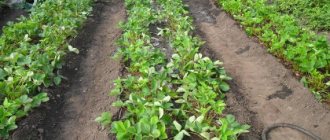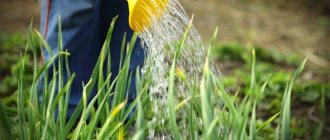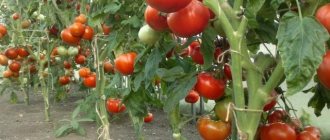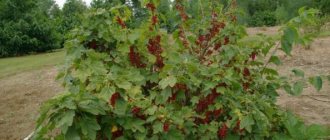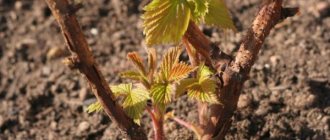Fruits and berries » Grapes
0
1006
Article rating
Kira Stoletova
Grapes are a southern plant. Thanks to the work of breeders who were able to develop frost-resistant varieties, this plant is successfully grown in Siberia and other regions with harsh climates. Proper pruning of grapes in Siberia is important to ensure a generous harvest.
Pruning grapes in Siberia
Growing grapes in Siberia: photos and videos
Growing grapes in Siberia is not entirely common, since the southern origin of this crop requires special agricultural technology to obtain a good harvest. A video with recommendations from experts will help beginners learn the basic aspects of caring for a plant, especially its planting and pruning.
Eustoma (lat. Eustoma)
Eustoma (lat. Eustoma) or lisianthus (lat. Lisianthus), gentian family. Biennial herbaceous flowering plant with flowers of various shades, highly branched. It is grown both in open ground and at home.
The fruits of grapes are so tasty and healthy that breeders could not ignore them. Thanks to their work, this crop began to be grown in Siberia since the last century. Despite the novelties of domestic and foreign selection, there is still an opinion today that it is simply impossible to obtain grapes in the Siberian region.
It is believed that if it does not freeze out in the first winter, it will be destroyed by spring frosts or early frosts in the fall. Of course, these statements have grounds, since gardeners tried to use agricultural technology traditional for the southern regions in Siberia - growing and cultivating technology.
Caring for grapes in autumn
Autumn watering
How to care for grapes in autumn? If the weather is not too hot, the grapes are not watered after harvest. In order to prepare the roots of the grapes for wintering, one abundant winter watering in October will be enough. If, when planting, you did not dig a pipe into the hole for watering and fertilizing, make shallow grooves around the bushes so that the water does not spread out when watering, but goes deep exactly where the roots of the grapes are located. Periodic loosening of the soil is necessary to avoid rapid evaporation of moisture and compaction of the soil.
Transplantation in autumn
It is also better to replant grapes in the fall, after the leaves have fallen, but before the first frost. The main task is not to damage the fragile rhizome of the plant in the process. You already know how to prepare a pit for grapes. Young three-year-old bushes are replanted together with a lump of earth, without shortening the rhizomes, and to prevent the soil from crumbling, the bush is not watered for several days.
Five to seven year old bushes are dug from all sides (radius of approximately 50 cm) as deeply as possible, but it is unlikely that the entire root will be reached, since sometimes the grapes go one and a half meters into the ground. Remove the bush, very carefully free the roots from the ground, remove the old parts of the rhizome. Trim off excess vines, leaving no more than two branches with one or two vines on each. Shorten the tops of the branches slightly. Seal the cuts with wax. Dip the rhizome into a clay mash with the addition of potassium permanganate and lower it into the hole at an angle. Then proceed as described in the section on planting grapes.
When to replant grapes in the fall so that they have time to take root in a new place? Yes, within the same timeframe as the initial planting.
Fertilizer
After harvesting, the grape bushes are weakened, and in order to prepare them for winter, it is necessary to add fertilizer to the soil. Fertilizer for grapes is applied in the fall once every three to four years, and it is best to use organic matter for this purpose, for example, in the form of mulch around a bush made from rotted manure or peat with the addition of ash. However, when feeding grapes, it is necessary to show a sense of proportion, since this is precisely the case when it is better to underfeed the plant than to overfeed.
Autumn processing of grapes
As soon as the harvest is harvested, it is necessary to treat the vineyard for various types of infections, both plant and animal, since in the spring it will be much more difficult to get rid of them. There are no longer any berries on the bushes, and strong drugs can be used.
Typically, the treatment of grapes is combined with shelter for the winter - the cut shoots are tied and treated with a five to seven percent solution of ferrous sulfate (500-700 g of the drug per 10 liters of water). This spraying will kill the infection on the surface of the vine, but pests and grape diseases such as mites and oidium will not be particularly affected - Thiovit or colloidal sulfur is used to combat these problems. If you find bunch budworm on grapes, use Rovikurt against it, and cercospora blight should be fought with Fundazol or Polychom.
Grape propagation
The easiest way to propagate grapes is by cuttings, or stems. During autumn pruning, you can prepare cuttings and put them in storage in order to plant them in the spring. Or you can try to root them at home in winter. But first you need to cut cuttings from a mature vine: the thickness of such a vine must be at least 7 mm, it is dark or light brown in color, hard and crackling when bent.
- Mulberry: cultivation, care, planting and pruning
Cuttings from green vines are not suitable. Select a vine that has already bear fruit, on which the “tails” from the bunches have been preserved, check that there are no mechanical damage or signs of oidium, mildew or phylloxera disease. From such a vine, cuttings 30-40 cm long are cut, which should have at least three buds. The most important task is to retain moisture in the chibouks, otherwise they will never take root. Therefore, you need to cut it so that on both sides the stem ends with tendrils or a “tail” from the bunch - the membrane in these internodes will protect the cutting from moisture loss.
The cut cuttings are placed in water for 6-8 hours, then, after drying, they are treated with a “phytodoctor” and, having been given a tag with the name of the variety, are tied into bunches. You need to store cuttings in a humid environment at a temperature from 0 ºC to 5 ºC - in the ground, in the basement or in the refrigerator, which is much easier. To do this, wrap the cuttings in damp cotton cloth and place them in a perforated plastic bag to allow air access. Check the fabric for moisture from time to time, and saturate it with moisture if it is dry.
In spring, seedlings are rooted.
Grapes in Siberia for beginners video
Before you start growing any crop, you need to familiarize yourself with the features of its agricultural technology. In order for the plant to feel good and develop, it is better to prepare seedlings from cuttings by asking your friends for them. It is also necessary to prepare and learn many aspects that are unknown to beginners:
- how to replant a purchased seedling and care for it before planting it in a permanent place;
- about preparing the hole and the process of planting cuttings in the soil;
- how to water after planting and during the growing season;
- about constructing a trench and covering branches during wintering;
- how to properly open a plant in spring.
The questions described in detail are covered in the video:
Formation of grapes in the third year
In the spring, after the frosts have passed, remove the cover from the grapevine. Tie long fruit arrows to the bottom wire of the trellis horizontally, with their tops in opposite directions.
Substitution knots
leave to grow vertically. During the summer, stems will grow from all the buds. At the beginning of August, carry out chasing - trimming the stems by 10-20 cm. This will increase the quality and quantity of berries.
Do not chase before August, otherwise a mass of shoots will appear on the vine.
in autumn
, after leaf fall, cut off the outermost 4 vertical shoots with part of the sleeve.
As a result, on each shoulder there will be one link with two vertical shoots. They should be pruned in the same way as in the second year. Cut off the shoot closest to the center, leaving 2 buds, and leaving the ones further away with 4 buds.
For all subsequent years of growth of the grape bush, pruning should be carried out in the same way as in the third year.
Attention: for greater reliability and reserve, you can leave more buds on the shoots, but no more than 10 on each. This is done in case of frost damage.
For example, the optimal number is 3 buds on replacement knots and 6-7 buds on fruit shoots. In the spring, if all the buds have survived, the excess ones can be cut off.
Growing grapes in Siberia video of autumn pruning
One of the most important elements in grape care is pruning. It is necessary for good growth and successful fruiting; it is performed several times a season in order to form branches, control overloading of bunches and for the development of bunchy branches.
As a rule, autumn pruning is carried out to prepare grapes for winter, and it consists of the following stages:
- preparation: how to remove stepchildren;
- formation of the fruit unit for the next year;
- sanitary pruning;
- separation of the new sleeve.
The video describes autumn pruning in detail:
Final trimming
Remove foliage before pruning
The second stage of pruning bushes takes place after the first frost, when sub-zero temperatures have killed the foliage. During this period, the movement of nutrients stops, and it is the ideal time to prepare the grape bushes for winter.
Read also: Tomato juice beneficial and harmful properties
When starting final pruning, remove all damaged foliage from the bushes. If at the first stage of pruning the procedure was performed from top to bottom, then at the second stage the movement occurs from bottom to top. Fruit links and knots are trimmed. After the grape bushes are pruned and cleared of leaves, the branches are tied into bunches, intercepted in several places with soft wire.
In this form, the bundles are placed on a substrate. The substrate can be wooden beams or spruce paws. This stage is important, since the vine should not come into contact with the ground. Otherwise, the vine may become saturated with moisture from the ground and become moldy. After the first frost, there is often a significant increase in temperature during the daytime, and this is quite enough for the proliferation of mold fungi.
The top of the tied vines is covered with spruce wood, boxes, roofing felt, plastic film and other moisture-proof materials. However, shelter made from such materials is temporary.
Grapes in Siberia video: bush formation in spring
In the spring, buds are laid for new shoots, and the plant requires special care and attention after sleep. It is important not to miss anything and help the grapes:
- decompose the plant after wintering;
- prepare the vine for fruiting;
- tie the branches to the trellis;
- standardize shoots for harvest.
The questions described in detail are covered in the video:
Growing grapes in the climatic conditions of Siberia is not so easy, but if you follow the advice of professional gardeners, which are presented in the videos, there will be no problems. Study the conditions for caring for the plant, and soon you will be able to enjoy a wonderful harvest.
Preparing grapes for winter
You need to prepare grapes for winter immediately after harvesting. At the end of August, 300 grams of ash are added to each grape bush. Ash is added to irrigation water. The value of wood ash lies in the fact that it is a concentrated source of potassium, which grapes need for successful ripening of the vine. Adding dry ash during the growing season of the plant and subsequent mulching helps destroy pathogenic spores of fungal diseases and provides the root system with the necessary nutrition.
During the first autumn frosts, it is better to remove the grapevine from the trellis and lightly cover it with non-woven material; when good sunny weather sets in, the vine can be raised again. The winegrower should know that it is not necessary to forcibly mechanically remove grape leaves. Natural leaf fall contributes to the ripening of the vine and its better wintering.
In the fall, usually in October, moisture-charging irrigation is carried out in the vineyard. Thereby saturating the soil with moisture in deep soil horizons. 50 - 80 liters of water per square meter are poured under young plantings. Irrigation rate for fruiting grape bushes: 100-150 liters per square meter of area. Good, moist soil will help protect the grape roots from freezing.
Compatibility of the Siberian climate with viticulture
For heat-loving and moisture-loving grapes, the most negative factor is the sharp fluctuations in average daily temperatures. In such conditions, the plant begins to slow down, become susceptible to diseases, and grow wood poorly and ripen poorly. But there are also positive aspects in the Siberian climate. Siberian grapes are less affected by pests and diseases, including fungal ones. There are no phylloxera aphids here and mildew (downy mildew) spreads only slightly on rare occasions.
Grape planting scheme
How to plant grapes if a plant planted in Siberia may die using the wrong technology? First you need to prepare it and then proceed directly to the planting process:
- If you bought seedlings back in March and they were stored in small cups, then transplant them into larger pots. Before the warm season begins, keep them on the windowsill.
- When the air temperature begins to warm up to twenty degrees, take the plant outside for a while. Start with an hour and gradually increase the time until there is full daylight.
- After that, start planting. A day or two before planting, water the seedlings well.
- Plant the grapes in the prepared hole.
- Sprinkle soil on top and pour in plenty of water. In one hole - a bucket of water.
How is a bush formed?
When you have just planted a seedling, it needs to be tied up. To begin with, a stake or any meter-high stick can act as a support.
When the first stepsons appear, pinch them. It is better to do this not at the very base, but after the second leaf. Many winegrowers believe that this improves the process of photosynthesis.
In mid-August, you can shorten the crown of the largest vines.
How to form a bush from two vines:
- In the autumn, you need to cut one shoot into four buds, and the second shoot into two.
- In the spring, rest them horizontally against the trellis. And place those sinuses that are just beginning to grow vertically.
- Next autumn, each long shoot (of four buds) needs to be cut into two equal parts. Next they need to be shortened: at the center by two buds, at the edges by four.
- Next spring, those vines that will bear fruit are tied horizontally, and the knots are left in a vertical position.
Further watering of the plant
Caring for grapes in Siberia is a complex of measures, and the most important part in it is watering. And although the grapes are not afraid of heat and drought, they still need to be watered. How can you tell when it's time to water it?
Pay attention to the leaves - if they become limp and sag a little, then the grapes can be watered. This will require about ten liters of water.
It is important not to skip watering during these periods:
- When the buds just opened.
- Two weeks before the plant begins to bloom.
- After flowering, one to two weeks.
- Before covering the grapes for the winter.
Pruning Siberian grapes
If in the first year of life the grapes produced only one shoot, then with the onset of autumn it needs to be cut back into two.
Experts do not recommend pruning in the spring, since the grapes are just beginning to gain juice and the “wounds” inflicted will not heal well. In the worst case scenario, he could die completely.
Related article: Muscat VIRA - table grape variety
At the beginning of June, clusters may already begin to appear. Leave the bottom ones and cut off the top ones. If you leave everything, they simply won’t have time to fully ripen.
Once you understand the principle of the Siberian viticulture system, you will be able to make your own decisions and prune grapes in different ways. This way you can find out which specific method is suitable for your plant to obtain a large harvest.
Fertilizer and hardening of varieties
Particulars of caring for grapes in Siberia also include properly selected fertilizer and hardening of the bush.
Nitrogen fertilizers are not suitable for grapes in this area. Because apart from the growth of leaves and vines, they do not provide anything.
It is better to choose mineral and potash fertilizers, as they help replenish lost nutrients. Feed twice during the entire season using the foliar method and always in soluble form.
The bush can be sprayed with wood ash extract.
Remember that grapes will take oxygen, hydrogen and carbon from natural sources - water and air. And you need to provide the rest: phosphorus, calcium, potassium, magnesium, sulfur, boron, manganese, zinc, copper and iron.
The best varieties for a vineyard in Siberia
Grape varieties for Siberia are represented mainly by the results of local selection, as well as by amateur winegrowers. Some European varieties and many varieties for the southern regions are suitable for growing in the Siberian climate.
- Early maturing hybrid forms of Siberian selection: “Siberian bird cherry”, “Buratino”, “Tomich”, “Riddle”, “Muscat”. Mid-early varieties: “Srostinsky”, “Katyr”, “Seyanets Sharova”. Mid-season: “Biysk-2”, “Obskoy”, “Dubinushka”.
- Of the varieties of non-Siberian selection that deserve attention: “Vostorg”, “Tukay”, “Aleshenkin”, “Pamyat Dombkovskaya”. Under film cover in the spring and autumn, varieties from the southern regions: “Cardinal”, “Husayne” can produce good yields.
- The varieties of American selection: “Lydia” and “Isabella” showed good endurance. These varieties are more suitable for winemaking; the taste of the berries is significantly inferior to other varieties grown in the Siberian region.
Care after pruning
After pruning, all branches and leaves are raked under the bushes and burned.
Grape bushes are covered after the soil freezes. In this case, the plants will undergo cold hardening.
Early covering of the bush leads to damping off, so you need to cover the grapes no earlier than the air temperature drops to -6 degrees.
For the winter, the sleeves and shoots of the bush are tied together and laid in a trench, which is covered with spruce branches, boards, agrofibre and film. The shelter should not be completely sealed, otherwise it will harm the bush or even destroy it. Several holes are made in the film to allow air to pass inside.
If the vines are not laid in a trench, a layer of spruce branches, foam plastic or plywood is laid out on the ground underneath them. Then the bush is sprinkled with earth or covered with any covering material.
For more reliable protection from the cold, when snow falls, a half-meter snowdrift is poured onto the bush, which remains until spring.
In early spring, when the snow melts and the ground dries out, the shelter is folded back to free and dry the vines. It is impossible for the process of sap flow in the plant to begin under cover; in this case, the grapes may be blocked and the buds will die.
After the vines dry, they remain pinned to the ground. The bush is covered with lutrasil or spunbond so that it does not suffer from bright sun and spring frosts.
After the last spring frosts have passed, the grapes are opened, the sleeves are secured with paper clips, hooks on the trellis from below parallel to the ground (at a height of 30 centimeters), the vines are positioned so that each does not interfere with the other. After this, the first spring feeding with complex fertilizers is carried out.
Planting and agricultural technology
In order to avoid disappointment, you need not only to choose the right variety, but also to know how to properly plant grapes in Siberia.
When setting up a vineyard, trenches and holes should be deep enough (up to a meter). A drainage base is laid at the bottom of the holes and trenches (ordinary gravel can be used). The next layer is humus or compost. Next, soil mixed with sand and humus is poured. The hole is not completely filled in; the seedling should be positioned slightly deeper to make it easier to cover. In a hole that is not completely filled in, we pour a mound of soil on which we place the seedling. Carefully straighten and place the roots around the circumference of the mound. Now we carefully fill the roots on all sides and hill up the young bush a little.
How to prune grape bushes correctly for a good harvest
Proper pruning of grape bushes determines not only the grape yield in the next season, but also their frost resistance and the overall health of the plants. Every novice winegrower should know several subtleties of pruning grapes in order to grow strong and healthy bushes on their plot.
Preparation for pruning
Before you start pruning, you need to do some preparatory work.
For pruning, take pruning shears, saws and, if necessary, a lopper.
Young shoots no more than 1.5 centimeters thick are cut with secateurs with 2 blades. When working, you need to take into account that the pruning shears should be positioned with a narrow blade towards the area of wood to be trimmed.
If the thickness of the perennial vine is less than 8 centimeters, a bow saw is used for pruning. If the branches are thicker, trim them using a hacksaw. In hard-to-reach places on the bush, a lopper is used.
Before work, tools, if necessary, are sharpened and treated with disinfectants (alcohol, potassium permanganate, copper sulfate).
Pruning an old bush
The grapevine has the ability to form fruit-bearing buds along its entire length. From any bud grow arrows capable of bearing several inflorescences. Throughout the entire shoot, the eyes have different fruitfulness. The most productive are the eyes growing in the middle (5-8 nodes).
There are several types of grape pruning: short (up to 5), medium (up to 9), long (up to 15 buds).
For different grape varieties, different types of pruning are used: short, medium, long and combined.
Frost-resistant and disease-resistant varieties are pruned with 2-4 eyes.
Young, weakened, damaged bushes are unloaded, cutting the shoots also short.
More cold-resistant varieties undergo medium pruning, leaving 7-9 eyes.
Heat-loving varieties and hybrids are cut as long as possible and 14-16 eyes remain.
An adult grape bush is pruned in several ways.
Methods for pruning grapes: diagrams in pictures
Formative pruning of a bush in the fall is carried out in several ways, such as: standard, fan and cordon.
Standard forming pruning is suitable for uncovered, frost-resistant grapes. These grapes require more space to grow, but produce much higher yields than other forms of pruning. The disadvantage of the standard form is the weak frost resistance of the grapes due to the fact that the bush cannot be covered for the winter.
On trellis bushes, 2 fruit links are formed, and on a two-plane trellis - 4. On arches, 8 or more evenly distributed links are formed. Each fruiting link is formed from 2 lower buds. In some cases, a fruiting link is formed at the end of the vine to create a new pergola floor. The established fruit link bears fruit for many years, renewing itself. The main thing is that the correctly selected fruit links are laid down first. Thus, the grapes bear fruit for many years in a row.
Fan formative pruning of a bush involves leaving several sleeves (links) on the bush (3 or more), which grow like a fan on vertical trellises. The advantage of this growing method is the ease of care and shelter for the winter, as well as adjusting the number of fruit links. The yield with such pruning is always stable.
Cordon formation implies the presence of 2 short sleeves on 1 or several shoulders. There are several types of cordon form, which differ in the number of sleeves left and the distribution of links.
Regardless of the pruning method, fruit-bearing links are completely removed from the vine. Tops and weak shoots that hinder the development of other shoots are also removed. Weak branches are considered to be vines that have less than 7-10 buds.
Any pruning is divided into 2 stages.
First, young shoots that have grown above the ground to a height of more than 60 centimeters are removed.
In young shoots, no higher than 30 centimeters in height, the top of the vine is removed by 10-15%. The side branches are shortened, leaving 2 sheets on each.
After half a month, fruitful arrows are laid for the next season. In this case, several strong, healthy branches are selected. The first one is pruned to 5-7 buds (this is the fruitful arrow). The second is shortened to 3 buds (this will be a replacement knot).
It is worth remembering that replacement knots are formed only from shoots older than 5 years. Before this, the skeletal and main branches of the bush are simply shortened from above.
All annual shoots are removed from old bushes. After pruning, no more than 30 eyes should remain on the plant. If there are more buds after pruning, then you can completely cut out 1 sleeve of the bush.
To minimize the negative consequences after pruning, you need to consider several points:
- The cuts are placed on one side of the sleeve (inside out);
- When pruning one-year-old wood, it is completely removed, leaving no stump. The cut should be perpendicular to the remaining part;
- on annual branches, after pruning, a protrusion of wood (0.6-0.9 centimeters) is left above the eye;
- When removing the rootstock, the top layer of soil near the trunk is removed, and after pruning the soil is returned.
Autumn pruning of the vineyard: video
Vineyard pruning
We figured out what it means to plant grapes in Siberia.
Now I would like to focus on how to prune correctly. The principles of its implementation differ significantly from manipulations with vines in the southern territories. The fact is that pruning during the period of increased sap flow somewhat slows down the budding, and, accordingly, the ripening of the crop. If in the south this is practically unnoticeable, then in the cold Siberian summer every warm day counts. Autumn pruning of grapes in Siberia takes place in two stages. The first stage is mid-August or late September. During this period, the harvest has already been harvested, but the growing season is not yet completely completed; there are still leaves on the bushes. At this stage, the fruit-bearing vine, old branches, weak and thin shoots are removed. Be sure to leave a fruitful arrow and a replacement shoot.
Before winter shelter. When sap flow has completely stopped, a second pruning is carried out. The more you prune the bush, the better it will be for the subsequent harvest. We shorten the fruiting shoot to 10 buds, and the replacement shoot to 2-3 buds. Next year, the fruiting arrow will actively grow, and the replacement shoot will produce a harvest. There should be only 2 shoots left on the bush after autumn pruning. This will prevent thickening and excessive load.
Why is autumn pruning necessary?
Pruning grapes in autumn in Siberia is an important undertaking. In northern regions, it is not advisable to leave pruning until spring. Before sheltering for the winter, the vines are tied into bunches.
In the spring, when the air temperature becomes above zero, a greenhouse effect will begin to form under the waterproof shelter. If the grapes have not been pruned, then unharvested foliage, buds and dead shoots will begin to rot. Since all the branches were collected in one bunch, healthy branches will also be affected by the fungus.
Most often, such a bush dies and is difficult to revive, so you have to grow the grape bushes again or wait a little for the underground buds to awaken.
Autumn pruning allows you to avoid such troubles; besides, after pruning, the bushes take up much less space and are easier to cover. Pruning grapes in Siberia has a number of features; it differs significantly from pruning in the southern regions.
Due to the harsh climate, the vine does not always have time to ripen; to help the plant, pruning is carried out in two stages:
- Lightening pruning.
- Final autumn pruning.
Load normalization
Excessive load on the bush can lead to the fact that the bunches may not ripen. Insufficient load is also not very good. In this case, the vine will actively increase the vegetative mass, which will also take a lot of effort.
In the first two years of life, the bush should grow freely, gaining strength. In the third year, the bush is pruned to 20-40 buds; in the fourth year, up to 60 buds can be left. Mature grapes, depending on the vigor of growth, can be trimmed, leaving from 80 to 150 eyes. Moreover, the smaller the grapes, the more eyes can be left without damage to the harvest.
Features of the structure and names of parts of the grapevine
The base of the trunk, which is located underground, is called the heel
, roots grow from it.
Stamb
- part of the stem up to the first lateral shoot, like all trees. In grapes, part of the stem is also underground, ending at the heel.
Head
- a thickening on the main stem from which side shoots extend.
Sleeves (shoulders)
- these are side shoots extending from the main stem. And the eyes on them are the same kidneys.
Read also: How to get rid of purslane in the garden forever
There are terms that need to be remembered: fruit arrow and substitution knot.
fruit arrow
– a long-cut sleeve, on which 8-12 buds are left after trimming.
Substitution knot
– short sleeve, after trimming there are 2-4 eyes left.
Fruit link
– a pair of shoots consisting of a replacement knot and a fruit shoot. We've sorted out all the names, let's move on to the secrets of pruning grapes.
Hardening of grapes
Hardening is another nuance that will have to be taken into account before planting grapes in Siberia. In spring, it is rarely possible to do without film cover, especially when it comes to varieties from the southern regions. But you shouldn't abuse it. As soon as the severe frosts are over, remove the film. Plants that are too pampered may not survive a harsh winter. This is the principle of hardening Siberian grapes. Over time, the plant adapts to temperature changes, shortening the growing season and fruit ripening.
Grape varieties for Siberia
The opportunity to grow large and sweet grapes in Siberia is a good gift for gardeners in this region. Varieties have been developed that are adapted to a sharply continental climate with strong fluctuations in both daily and annual temperatures. The warm period without frost here lasts three months: from early June to early September. Therefore, early varieties grow well in Siberia: Muromets, Solovyova-58, Tukay, Rusven, Kodryanka and other early ripening varieties, in which 90–115 days pass from bud break to full ripeness of the berries.
Photo gallery: grape varieties suitable for growing in Siberia
Rusven grapes attract wasps with their large sweet berries and need to be protected with a net
Large Kodryanka berries are collected in clusters weighing 400–600 g, but some reach 1.5 kg
The Solovyova-58 grape variety is well suited for winemaking
Muromets - grapes for raisins, the pulp is fleshy, without aroma, the weight of the brush is up to 400 g
Tukai grapes are distinguished by their strongly growing bush and large clusters
Winter shelter
How to cover grapes for the winter in Siberia? There are subtleties here. We lay protective material on the vines at the end of October in the following sequence:
- After pruning, the vine is removed from the trellis and laid along the trench;
- Only dry vines should be covered; wet vines will rot and be affected by fungi;
- Covering material is laid on top. You can use film or thick waterproof fabric. The shelter is dug in on both sides;
- A protective layer is placed on top. The best option is coniferous spruce branches, for example, pine;
- In winter, make sure that the snow cover covers the vineyard as much as possible. If necessary, use snow guards;
- In April, the shelter is removed and a film greenhouse is installed in its place. It will be possible to remove it in May-early June.
We have provided basic recommendations on how to grow grapes in Siberia. Taking them into account, you can get a good harvest of delicious berries.
Why do you need shelter?
Most grape varieties are heat-loving plants, and this applies even to those varieties that are considered frost-resistant, withstanding temperatures down to -25°C. With prolonged exposure to frost on the root system of these plants (-5°C or even lower), it will be on the verge of freezing, and if the outside temperature is kept within -20°C for two weeks, more than half of the buds or even the vine itself will suffer.
Did you know? According to experienced gardeners, in order to maintain 1 degree of soil temperature, it is enough to place 1.5–2 cm of snow on the bush. That is, a snowdrift 30–40 cm high will be enough for the plants to survive the winter calmly.
All of the given values are typical for many regions with a temperate climate, not to mention the harsh conditions of Siberia. Therefore, in order to prevent the death of grapes and provide themselves with a harvest in the next season, winegrowers cover the vine, thereby protecting not only the above-ground part, but also the rhizome from freezing.
Features of growing grapes in Siberia
Many gardeners living north of central Russia, especially beginners, mistakenly believe that grapes are an exclusively heat-loving plant and do not undertake their cultivation. In fact, it is enough just to select special varieties that will easily withstand winter frosts.
Varieties for Siberia
Grape varieties suitable for growing in Siberian conditions:
- Early ripening grape variety "Sibirskaya Cheryomushka". Medium height bush. The berries are small, sweet, blue in color, and taste like bird cherry. This grape variety has high winter-hardy characteristics.
How to plant correctly?
Planting grapes in Siberia for beginners:
- The first thing to do is choose a landing site. The place should be sunny and dry, located at an elevation. Decide on the direction of the rows, as well as the number of bushes in the row (the distance between the rows should be at least two meters, the distance between the bushes from two and a half to three meters).
- Markings are applied to the selected area using a rope (indicating rows) and pegs (indicating holes for seedlings).
- To carry out planting, either planting holes are dug (depth - 1 m; diameter - from 80 to 100 cm) or a trench (depth - 1 m; width - 1 m).
- You should take care of the filler for the pits in advance. The lower part of the hole is filled with humus and soil from the top fertile layer of soil, then mineral fertilizers are added (from 0.5 kg to 1 kg per hole). Then you should mix everything and repeat the procedure (until the pit is filled to the brim).
- A hole is dug in the center of the prepared planting site (the depth should be such that the seedling with roots fits into it, and there remains an additional ten to fifteen centimeters from the head of the seedling to the top of the hole).
The most suitable period for planting grapes in Siberia is May, but winter-hardy varieties take root well in the fall. Before planting, the cuttings are kept for 24 hours in a warm stimulant solution. It is necessary to plant cuttings with a slope of forty-five degrees towards the north.
You can get acquainted with the process of planting grapes from cuttings in Siberia by watching the video:
Maiden grape is a fast-growing vine, reaching a length of up to twenty meters. In Siberia, due to more severe climatic conditions, the plant may have a more modest size. Maiden grapes are an ornamental plant, since their berries are not edible. Maiden grapes are planted in holes or trenches sixty centimeters deep and wide. If necessary, a drainage layer fifteen centimeters thick can be installed at the bottom. It is recommended to plant seedlings no older than two years in a permanent place. Caring for the plant consists of regular watering (when planting the plant, it is necessary to form watering holes), pruning and applying fertilizers to the soil. It is recommended to mulch the tree trunk area.
How to grow?
Some tips for beginners on growing grapes in Siberia:
- Grape shoots should only be grown in a vertical position, since the vine will not ripen in a horizontal position.
- On the main vine, the growing stepsons must be pinched, leaving two leaves.
- Young animals must be fed.
- In the second half of September, after the first frost, it is necessary to prune, leaving only the ripened part.
You can get acquainted with the process of growing grapes in Siberia by watching the video:
Care for beginners
Caring for grapes in summer in Siberia consists of:
- In tying up young shoots.
- In regular stepsoning.
- If two clusters form on the shoots, then the upper one is removed (it is usually smaller).
From the first of August to mid-September, it is recommended to carry out two or three feedings (30 grams of phosphorus and potassium extract per 10 liters of water).
From the second half of September, when the first frosts kill the leaves and the upper part of the vine, you can start pruning. If annuals are pruned, then two shoots of 20–30 cm each are left without leaves or shoots. Second-year students are left with two shoots ranging from one to one and a half meters long. In the third year, in addition to these two shoots, two additional shoots are left. When pruning, it is imperative that two fruit shoots and one replacement knot are left on the shoots.
How to prepare for winter?
There are many ways to cover grapes for the winter in Siberia: some people prefer to cover them with 20 cm of soil; some people prefer to cover with light bulk materials such as sawdust; as well as spruce branches, straw, etc.
It is recommended to pay attention to the following method of shelter:
- With the help of boards (installing them on the edge and fixing them with pegs), a kind of gutter is equipped. The width of the gutter is maintained at approximately half a meter. The optimal thickness of the board will be two and a half centimeters, and it is better to choose a width of fifteen to twenty centimeters.
- After pruning, the vines are placed in a trench.
- The top of the gutter is covered with a wooden shield.
- A film is laid over the shield.
There is another subtype of this method, the principle of which is that there is no wooden gutter, and the grapes are covered with wooden shields, which are installed like a gable roof.
The method of planting grapes in a trench with deepening of seedlings already implies the creation of a permanent covering groove half a meter wide and twenty to thirty centimeters deep. The walls of such a groove can be strengthened in advance using boards or slate. For the winter, the vine is placed in these grooves, secured with special hooks and covered with earth. This planting method will allow grapes to comfortably overwinter in Siberian conditions, preserving not only the shoots, but also the root system.
No shelter
In Siberia, it is more advisable to plant frost-resistant grape varieties. In regions where in winter the air temperature does not drop below - 20ºС, winter-hardy grape varieties (under the condition of deep planting) can easily overwinter without shelter. Otherwise, absolutely all varieties of grapes are covered, regardless of their variety.
When to clean?
When the grapes are covered
It is necessary to cover the plants during the period when the average daily temperature is within -5 ° C, in other words, when the soil is already thoroughly frozen and it is simply impossible to stick a shovel into it. Then the grapes are covered with insulating materials: tops, bags of tyrsa, dry leaves, etc., and covered with moisture-proof materials on top.
Do not forget that the buds on grape bushes can withstand frosts down to -17 °C, but the roots of plants can be damaged even at -8 °C. Therefore, the roots also need to be given due attention. Snow provides good cover.
The thicker the layer of snow in the region, the thinner the layer of insulation needed for covering. The thing is that a centimeter of snow can keep the temperature by 1 °C. If there is a lot of snow in the region, then it is enough to cover the plants with waterproof material.
Grape pruning
- one of the most difficult events held at the dacha.
Sometimes it is difficult to figure out how to prune grapes
and when.
Pruning a grape bush comes down to cutting off 90 percent of the vine, leaving the required number of eyes (buds).
Let's take a closer look at the secrets of proper pruning of grapevines.
, starting from the first year of planting.
Pruning of grapes can be done both in spring and autumn. When pruning in the fall, it is advisable to cover the bush for the winter, protecting it from freezing. If your area has harsh winters, prune in the spring or cover the vine for the winter. By the way, unpruned grapes withstand winter better.
Features of the climate of Siberia
In Western Siberia the climate is sharply continental, and the weather conditions in the eastern part of Siberia are influenced by the relief features. Winters in the macroregion are long and frosty, and summers are short. But such conditions also have advantages for gardening. The grapes are resistant to pests and are not susceptible to diseases. In Siberian conditions, it is not affected by the dangerous phylloxera aphid.
Despite the climate, early and some mid-season varieties grow successfully and produce a harvest, provided that the vine is covered and protected from freezing.
Timing for covering grape bushes in Siberia
Siberian autumn takes a short period of time, no more than two months, and quickly turns into a harsh, long winter. For this reason, they begin to cover the grapes at the end of September - beginning of October in order to catch them before the first frost. But there's no need to rush.
You can remove the vine from the trellis earlier, but it is better to wait until the leaves fall and do not pick them off yourself. At this time, complex biochemical processes take place in the vine for the complete ripening of shoots and buds.
At what temperature should you cover grapes?
There is no need to wrap the entire bush at once. Temperature changes can cause condensation to form and dampen the plant. A period is needed when the fluctuations in sub-zero temperatures pass - before the snow falls. It is useful to harden the plant at -5...-8°C. Finally, the grapes can be covered at a constant temperature below -10°C.
Reference. In Siberia, the covering of grapes is completed by mid-October.
Young plant
In the harsh conditions of Siberia, two methods of covering grapes are usually practiced. The first method, or as it is also called “dry”, allows you to create comfortable conditions for the plant. The vine is tied and wrapped in polyethylene or roofing felt. So, it will not touch the ground. After this, metal brackets are used to secure the vine to the bottom of the trench.
Arcs are installed above it, special cardboard is fastened on top of them and then covered with polyethylene. This will further protect the plants from moisture. Cardboard can be replaced with wooden boards. The second method does not require the use of prepared materials. Regular soil and snow will help cover the plants.
A solution of lime, which is applied to the grape bushes before sheltering, will help to avoid diaper rash on the plant during wintering.
Open the grapes immediately. This should happen gradually. After the temperature becomes stable and the snow begins to melt.
In order to remove the insulation from grapes, do the following:
- As soon as the snow melts, it is necessary to remove the waterproofing, that is, polyethylene.
- It is possible to completely remove the cover from the plant only in the second half of April. Then you can remove the most basic structure and free the vines.
- It needs to be dried and ventilated. It is important to remember that you should never tie it.
- After the stems have dried, they are untied and laid down. It is also not recommended to tie them. If frost occurs at night, the plants need to be covered again.
It is important to be very careful and it is advisable to do this in cloudy weather. Since bright sunlight can damage the plant.
Young grapes are usually covered with 5-liter plastic bottles. Having previously made a cut on them for ventilation. After this, you need to fill it with earth up to these cuts. After the temperature reaches negative values, the bottle is completely covered with soil, 5-10 cm above it.
Caring for grapes is easy. With proper care and preparation for wintering, the plant will only say thank you and will delight you with a good harvest in the fall. You can make the covering material yourself, or you can buy a ready-made product. Have a good harvest!
There are no special requirements for covering material for grapes, however, when choosing a cover, it is worth excluding the possibility of moisture appearing on the vine, due to which it subsequently freezes. If you are going to use polyethylene or other similar fiber, make sure it has holes for filtering.
In addition, an important feature is the strength of the selected product, so if you focus on plastic film, then choose only dense varieties that can retain their qualities for several years.
Sometimes old metal sheets, slate and even used plastic bottles are used to cover the vine, which, after soldering, turn into a good above-ground frame.
Important! In addition to protection from the cold, grape bushes also need to be protected from rodents, so it is better not to use sawdust and hay to insulate the shoots to prevent mice from infesting them.
From ready-made products, agrofibre can be purchased to cover grapes, although some gardeners prefer to use it only in spring, when there is a risk of light return frosts. In winter, such material often allows moisture to pass through, so in addition to it you will have to use an intermediate layer that provides more reliable shelter.
There are many methods for covering grapes in the Siberian regions, because every gardener chooses the option that will be the most accessible and simple for him. Here are some popular examples of constructing a protective layer:
- Option 1. After removing the shoots from the supports, they are cut off and laid on sawdust or boards, additionally covering them with spruce branches on top. It retains snow well, but for additional insulation it is advisable to use a layer of covering material (for example, you can wrap the vine in front of it with polyethylene or roofing felt). To prevent the vine from rising from the surface of the ground, it is attached to it with special metal brackets or wooden hooks.
- Option 2. It is used more often than the previous one, since it does not require practically any special materials from the winegrower to cover the bushes. To protect them from the frosty winter, mainly only soil and snow are used, under which the grapes are well preserved even in the harshest winters. In this case, the vines are tied into bundles and placed in specially dug trenches, which are then covered with soil to a height of about 30 cm from the surface of the earth. When snow falls, the layer of cover will become even larger, which will further insulate the branches.
- Option 3. Sometimes fallen leaves are used as a covering material. It is poured in a thick layer (at least 30–35 cm) on top of grape shoots fixed close to the ground, and a film is pulled on top. To prevent fallen snow from sliding on it, you can also lay a layer of raspberry stems or dried sunflower tops on top. After snow falls, it must be covered with a layer of at least 50–60 cm.
We suggest you familiarize yourself with: Chalet with white windows
In the spring, as the snow melts, the insulating structure can be dismantled. In the first days of a steady thaw, the snow-retaining devices are removed, and after the snow has completely melted, the waterproofing layer can also be removed. The main shelter is removed only at the end of the second half of April, after which the vine can be lifted from the trench and hung on supports for further ventilation.
Important! After removing the vine from the supports, you need to bend it towards the ground very carefully, without sudden movements. Even if the cracks are not visible externally, individual fibers inside may break, which will harm the further development of the grapes.
It will be possible to finally open the grapes and secure them again on the supports no earlier than the middle or even the end of May. In general, caring for vineyards in harsh climates involves performing the same actions as when growing in the rest of Russia, albeit with a slight shift in the usual timing.
The opening of the grapes in the spring is carried out gradually as the snow melts. At the very beginning of the thaw, snow retention devices are removed. When the vineyard is completely free of snow cover, it is already possible to remove the waterproofing.
The main covering materials are removed only in the third ten days of April, and the vine is lifted from the trench and hung to dry on the bottom row of the trellis.
After the vine has completely dried, it is freed from the bunches and laid out in a trench, if necessary, immediately protected from the frequent night frosts during this period, which are destructive for shoots that have just begun to develop.
The grapes are finally opened only when the threat of frost has completely disappeared, carefully tying the vines with tender shoots to the trellises.
All manipulations for the final opening of the grapes must be carried out only in cloudy weather or in the evening in order to protect the still weakened plants from drying out in the active spring sun.
Grape bushes planted this year are not pruned. Only non-fallen leaves are removed from them. The bushes are watered; there is no need to apply fertilizers - they are applied during planting. Grapes of the second year of life are pruned, leaving 3-4 buds on one or two shoots. In the next two years, from 3 to 7 buds are left on the bush in the fall on mature shoots. Starting from the 4th year of life, fertilizers begin to be applied in the fall.
Sheltering annual grapes for the winter. Do I need to cover young grapes for the winter?
Experienced winegrowers advise making shelter for the winter in any case - with the exception of those climatic zones where there are no negative temperatures in winter. The harsher the winter, the more carefully you need to prepare winter shelter for young grapes. In order to maximize the safety of a vineyard with young seedlings in the cold, you need to take care of creating a reliable complete shelter that will protect the entire queen cell.
The most dangerous thing that can happen to a vine is icing. Only shelter can save you from it. Do not be afraid that the frosts will be much weaker than predicted, and a well-sheltered plant will end up in greenhouse conditions (which is fraught with premature bud break).
The design of the created shelter assumes the possibility of artificial ventilation, when from the cocoon created by blankets, films and other things, with the threat of creating a greenhouse effect during warming, outside air with a sub-zero or cool temperature is brought in, and warm air is released. This procedure will avoid rotting and the appearance of early buds.
If the climate of the region allows the grapes to enter winter without shelter or with minimal protection, but frost suddenly strikes, there are methods that could correctly be called anti-crisis. The first is to carefully bend the vines to the surface of the soil, fix them with staples and pour a sufficient layer of soil on top of the plant. You should get a tent-like formation along the entire length of the vine. If the temperature suddenly drops to a critical level and such an earthen tent cannot fully protect the young grapes, it is recommended to save the vines at night with the help of fires that are lit next to the bushes. This measure can only be applied to the southern regions, where frosts are rare, and if they do occur, they last no more than 1-2 days.
Proper construction of the shelter, taking into account the climatic characteristics of the area, will allow the grapes not to freeze in the most severe frosts and, after the onset of spring, to begin a full entry into the new fertile season.
How to cover a bush for the winter?
When you have harvested Amur grapes, virgin grapes or any other variety, you must immediately begin protecting the bush from the first cold weather:
- Place a film and bag on the ground and remove the vines from the support.
- Place them on a bag or film.
- Build a tunnel-shaped shelter on top like a greenhouse. To create it you will need polycarbonate.
- This will help the leaves of the plant not to freeze when the first frosts begin, and if the autumn weather in Siberia pleases with Indian summer, then photosynthesis and bud growth will continue in the grapes.
- After the leaves fall, the structure must be disassembled. While leaving the film or bag on the ground.
- Start building a new shelter. It will look like a box with sides. Don't forget to leave room for the grapes between the walls so they can breathe.
- Insulate the sides of the shelter using any suitable material: burlap or cardboard. You can also use foam and spunbond.
- Place a film on top to prevent water from getting inside. For better protection from moisture, you will need slate.
During wintering, the plant should not touch metal objects. Otherwise, the kidneys may die.
When spring comes, the protective structure can be removed. This usually happens in mid-April. Don't wait for the soil to thaw before raising the vines.
After this, you need to make the same structure as in the fall - like a greenhouse.
You can start gartering only after a consistently warm temperature has been established and the likelihood of cold weather has decreased.
How to prepare grapes for shelter in Siberia
Preparing the bush for winter begins in September immediately after harvesting. It includes pruning, watering, fertilizing. The growth of the vine and next year’s harvest depend on how the plant overwinters.
Trimming
Pruning makes it easier to cover the vines. The best time for the procedure is mid-September, but at least 1-2 weeks after harvest, so that the plant has time to recover. If by that time the bush has not dropped its leaves, they are shaken off by hand. If you prune before leaf fall, the vine will lose its plasticity. Such branches will break when placed in a trench.
Trim the vine down to living wood - its cut should be light green. 1-2 cm of shoot are left above the living bud. After pruning, a certain number of buds should remain on each fruit branch, depending on the thickness of the shoot:
- 5 mm - 5 pcs.;
- 6 mm - 5-6 pcs.;
- 7 mm - 7-8 pcs.;
- 8 mm - 8-9 pcs.;
- 9 mm - 9-11 pcs.;
- 10 mm - 11-13 pcs.;
- 11 mm - 12-14 pcs.;
- 12 mm - 13-15 pcs.
30% of spare eyes are left on the plant in case of freezing.
Important! Fruit-bearing shoots are shortened by 60-90%.
Watering
The frequency and abundance of moisture depends on the composition of the soil. Sandy substrate requires frequent but moderate watering. Clay soil is watered rarely and abundantly. After harvesting, watering can be stopped for a while. This imitation of drought will accelerate the ripening and lignification of the vine, and the grapes will overwinter better.
Moisture-recharging irrigation is carried out at the end of September, on the last sunny days. After it, the lashes will be saturated with moisture, become flexible, and will be easy to bend to the ground. For fruit-bearing plants, the norm is 100-150 liters per 1 square meter. m landings.
Top dressing
During the growing season, the plant uses up its entire supply of nutrients. To set the buds of the future harvest, it is necessary to fertilize it:
- Spill the soil with a solution of phosphorus and potassium fertilizers (20 g and 10 g per 10 liters of water).
- Once every three years, the following composition is applied to the bush: 1 kg of chernozem, 30 g of superphosphate, 30 g of potassium fertilizer.
- You can add boric acid, potassium permanganate, iodine and zinc sulfate to water for irrigation, but not more than 15 g of each substance per 10 liters of water.
Before winter, grapes should not be fed with nitrogen-containing mineral compounds, which cause rapid growth of green mass.
Treatment against diseases and pests
Fungal spores found on bark and foliage survive at sub-zero temperatures. To prevent their re-spread, it is necessary to carry out preventive spraying with 1% copper sulfate. In the fight against oidium and mites, the drugs “Nitrophen” and “DNOC” are suitable.

